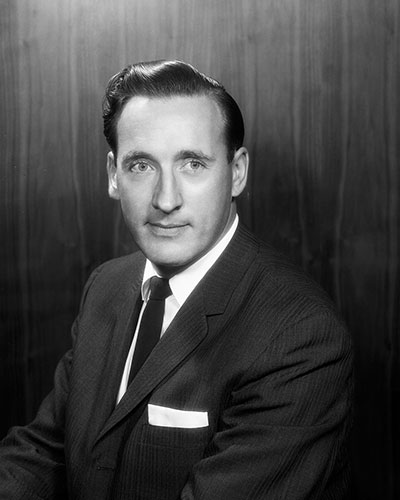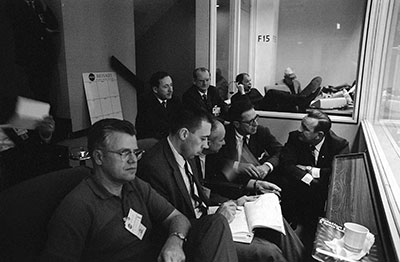Godspeed, Mr. Rose.
Below is an obituary written by Chris Gainor (sent to me via e-mail).
Rodney G. Rose, 1927-2014
Flight Operations Directorate, Johnson Space Center
On Christmas Eve, 1968, the crew of Apollo 8 made history when they became the first humans to travel to the vicinity of the moon. At the start of Apollo 8's third orbit of the moon, spacecraft commander Frank Borman called to mission control in Houston to see if Rod Rose was there.
Rose was expecting the call, because he and Borman were friends and neighbors who lived near the mission control center. At the local Episcopal Church, St. Christopher's, both were members of the vestry, the group of lay advisors who helped run the church.
Two weeks before Apollo 8 left for the moon, Borman found out that he was on the duty list as a lay reader for the Christmas Eve communion at St. Christopher's. Knowing that he was scheduled to be circling the moon at that time, Borman got agreement from the minister, Jim Buckner, that he could deliver his reading from lunar orbit for recording and later playback at the service with Rose's help.
Rose selected for Borman's reading the Prayer For Vision, Faith and Work by G.F. Weld from "Prayers for the Church Service League," published by the Diocese of Massachusetts, and gave a copy of the prayer to Borman. "We decided to call it experiment P 1, and Frank agreed to give me one lunar orbit notice before he read the prayer so all the recording could be finalized," Rose recalled.
A few minutes after Borman's call to Rose from Apollo 8, capsule communicator Mike Collins said, "Rod Rose is sitting up in the viewing room. He can hear what you say."
"I wonder if he is ready for experiment P1?" Borman asked.
"He says thumbs up on P1," Collins replied.
"Rod and I got together and I was going to record - say a little prayer for our church service tonight," Borman said. When Collins gave the go-ahead, Apollo 8's commander continued, "Okay. This is to Rod Rose and people at St. Christopher's, actually to people everywhere.
"Give us, O God, the vision which can see Thy love in the world in spite of human failure. Give us the faith, the trust, the goodness in spite of all of our ignorance and weakness. Give us the knowledge that we may continue to pray with understanding hearts, and show us what each of us can do to set forth the day of universal peace. Amen."
"Amen," Collins replied.
"I was supposed to lay read tonight and I couldn't quite make it," Borman concluded.
"Roger, I think they understand," Collins said.
This was the first prayer broadcast from space. That evening, the crew of Apollo 8, Bill Anders, Jim Lovell, and finally Borman read the first 10 verses of Genesis back to Earth as the grey, battered surface at lunar sunset appeared on television pictures they also sent back. Rose went to St. Christopher's with tapes of the prayer that Borman had recorded that morning and the Genesis reading, and both were played at the service.
Although unknown to the public, Rose was well known to the astronauts and the managers of the Apollo program because he played a key role in organizing the flights. Rose, one of the unsung heroes of the Apollo program, passed away Jan. 8, 2014 in Houston at the age of 85 after a long illness.
While most people who worked in Apollo were American, Rose was a prominent member of a small but important group of British and Canadian engineers who helped NASA's early human space programs after they lost their jobs when the Canadian government cancelled a major aircraft program.
Rodney George Rose was born August 10, 1927, in Huntingdon, England. As a student in wartime and postwar England, Rose had attended the Manchester College of Technology while serving a five-year apprenticeship at A.V. Roe in Manchester. Upon graduating from the college and completing his apprenticeship, Rose won a scholarship to the newly established College of Aeronautics at Cranfield, which he attended from 1949 to 1951. He then went to Supermarine, then famous as the home of the Spitfire of Battle of Britain fame, where he worked on aircraft performance, loads and engine performance.
In 1956, Rose had decided that he had gone as far as he could at Supermarine, and he was frustrated by the state of the British aircraft industry. After reading in the paper about Avro Canada, which was building jet interceptors for the Canadian government at their plant near Toronto, Rose crossed the Atlantic early in 1957 with his wife Leila and their two sons.
During his 23 months at Avro Canada, he worked as an aerodynamicist on the CF-100 and the CF-105 Avro Arrow jet interceptors, and also in flight test and in advanced design. The CF-100 went out of production in 1958, and on February 20, 1959, the Canadian government cancelled the Arrow program, leading to the closure of Avro Canada and the loss of employment for thousands of engineers and skilled workers.
At that time, the National Aeronautics and Space Administration was in its early months of existence and was looking for talent. Officials from NASA's Space Task Group, which grew into the Johnson Space Center, hired 31 of the top engineers from Avro, including Rose. In the Mercury program that flew America's first astronauts, Rose worked as project engineer on the Little Joe rocket that was used to test the Mercury spacecraft before it was launched atop larger rockets into space.
Rose also worked on recovery systems for both the Mercury and Gemini spacecraft. During the early 1960s, Rose represented the Flight Operations Directorate in meetings with Apollo spacecraft contractor North American Aviation, and when the Gemini program began flying, he became a key member of the flight operations team headed by Christopher C. Kraft Jr., NASA's first flight director and later the director of the Johnson Space Center.

Rose was an assistant to Kraft and chaired the meetings that drew up the Flight Operations Plans that guided Gemini and Apollo missions. Every organization involved in the conduct of each flight, including the astronaut crew, were represented at these meetings, where decisions would be made about what would happen in each flight and when it would happen.
"Basically I conceived the idea that in order to get a successful mission from the operations plan, all the players needed to be aware of what everyone else was doing, and making sure that everyone was playing from the same sheet of music," Rose explained. The plans not only affected the spacecraft and its controllers, but also launch teams, the ships and aircraft on station to recover the astronauts, the ground stations, and the trainers for the astronauts and the controllers.
Rose's soft voice and easy smile belied the fact that he was never afraid to stand his ground or make a point in the often contentious process of planning the Apollo flights. "I put him on my staff, and whenever I had a problem, whenever I wanted an answer, whenever I wanted anything done right, I gave it to Rod Rose," Kraft explained.
"I was never a head nodder," Rose said. "If It needed to be pointed out, I'd point it out."
In addition to his role in facilitating the first prayer broadcast from space, Rose was especially proud of his preparatory work on Apollo 8 because of the short time that was available to plan the historic mission after NASA leaders decided to send it to the moon. For missions like Apollo 8 and the the subsequent lunar landing missions that passed through the Van Allen radiation belts, Rose also chaired a panel of experts that ensured that the Apollo astronauts were not exposed to dangerous levels of radiation from the Sun.
In the early years of the Space Shuttle program, Rose continued his work of preparing Flight Operations Plans. Because the shuttle was seen as an operational vehicle, these plans were increasingly standardized. Rose also worked on integrating the shuttle's communications and data systems, and he also represented the Flight Operations Directorate in discussions with U.S. Air Force range safety officers.
Rose retired from NASA in 1984, and after working for Rockwell for five years, he and Leila retired to Wimberley in the Texas Hill Country, although they returned to the Houston area as Rose's health declined.
Rose became a U.S. citizen in 1964, but he was always proud of his British heritage, and he was known as the historian of the group of engineers who came to NASA from Avro Canada.













